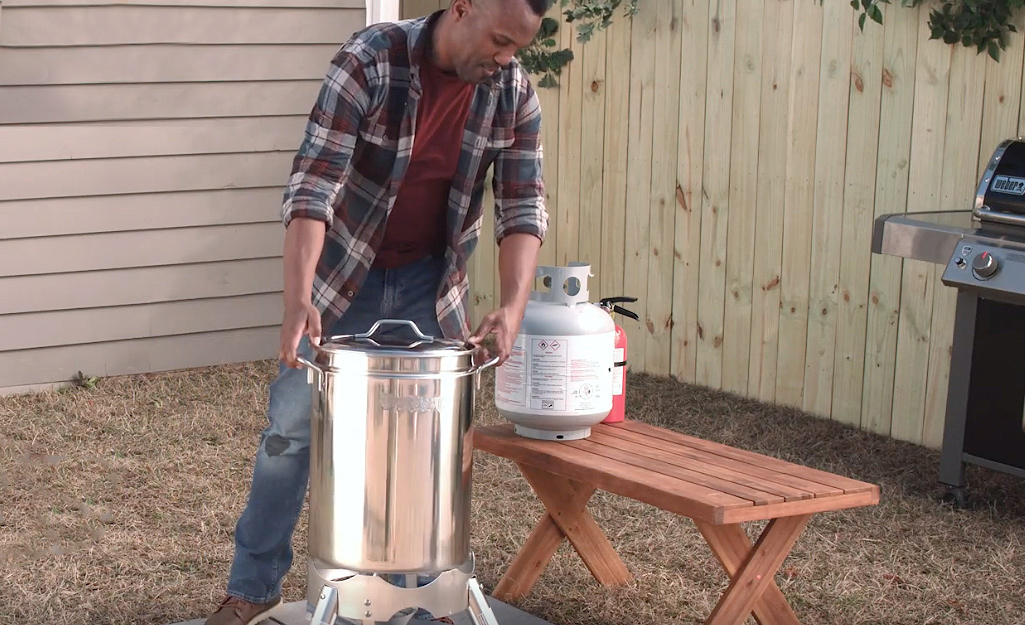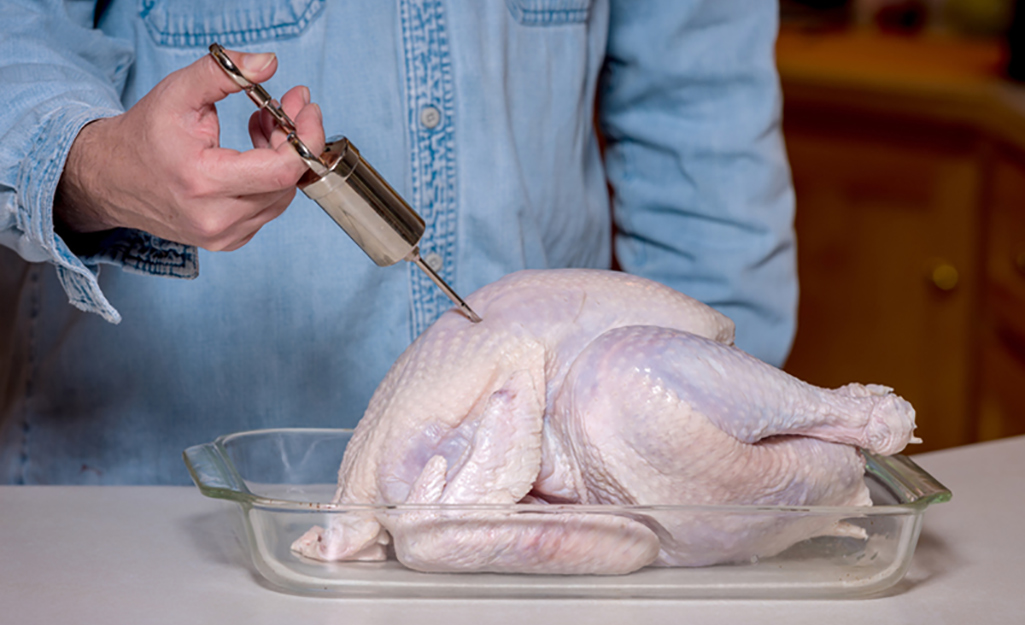Deep frying a turkey isn’t just for Thanksgiving. It’s a method to quickly prepare a delicious bird any time of year. You need to understand the ins and outs of deep-frying turkey if you want to prepare this holiday staple while adhering to safety regulations.
You can safely deep fry a turkey indoors or outdoors with the help of this guide, which also includes setup instructions for your turkey fryer. Common queries like “How much oil do I need?” and “How long does it take to fry a turkey?” will also be addressed in this guide.
Safety Advice: Avoid frying frozen turkeys as they may explode in the hot oil, posing a risk of burns and injuries. Make sure your turkey is completely thawed before frying. Jump to Specific Section.
Ah, Thanksgiving A time for family, friends, and, of course, the pièce de résistance: a juicy, golden-brown turkey. But who wants to spend hours slaving over a hot oven when you can have a perfectly cooked bird in a fraction of the time? That’s where deep frying comes in, folks
But before you go splashing oil and tossing in your feathered friend let’s talk about the oil. It’s the unsung hero of this culinary adventure and choosing the right one can make all the difference between a crispy masterpiece and a greasy disaster.
So, what’s the best oil for frying a turkey?
Well, it’s not a simple “one size fits all” answer. It depends on a few factors, like your budget, taste preferences, and even the size of your turkey. But don’t worry, we’ve got you covered.
The contenders:
- Peanut oil: This classic choice boasts a high smoke point (meaning it can withstand high temperatures without burning), a neutral flavor that won’t overpower your turkey, and a crispy texture that’ll have everyone licking their fingers. It’s a bit pricier than other options, but the results are worth it.
- Safflower oil: Another high-smoke-point contender, safflower oil is a budget-friendly alternative to peanut oil. It also has a neutral flavor, making it a versatile choice for frying.
- Refined soybean oil: This readily available oil is another affordable option with a high smoke point. However, it does have a slightly stronger flavor than peanut or safflower oil, so keep that in mind when choosing your recipe.
- Sunflower oil: Similar to soybean oil, sunflower oil is a budget-friendly option with a high smoke point and a neutral flavor. It’s a good all-around choice for deep frying.
Can you use vegetable oil?
The answer is a bit tricky. “Vegetable oil” is a broad term that can encompass various oils, including soybean, canola, and grapeseed. Some vegetable oils have a high smoke point suitable for deep frying, while others don’t. So, check the label carefully before using vegetable oil for your turkey.
How much oil do you need?
This is where things get interesting. You’ll need enough oil to completely submerge your turkey, but not so much that it spills over. A general rule of thumb is to use 3 gallons of oil for a 30-quart pot and 3.3 gallons for a 32-quart pot.
And what about reusing oil?
Yes, you can reuse peanut oil up to three to five times within six months, as long as you follow these steps:
- Allow the oil to cool completely before removing it from the pot.
- Strain the oil to remove any food particles.
- Store the oil in its original container in a cool, dark place.
But wait, there’s more!
If you’re looking for a healthier alternative, you can also try an oil-less turkey fryer. These nifty contraptions use infrared heat to cook your turkey, resulting in a crispy bird without the need for gallons of oil.
So, what’s the verdict?
The best oil for frying a turkey depends on your individual needs and preferences. But with this guide, you’re well on your way to achieving golden-brown perfection and impressing your Thanksgiving guests.
Happy frying!
How to Set Up Your Turkey Fryer

How to set up an outdoor turkey fryer:
- A burner, stand, pot, thermometer, hanger or basket, and lowering mechanism are all included in an outdoor turkey fryer. You’ll need to provide a propane tank.
- Choose an open space to set up your outdoor fryer. It ought to be at least ten feet away from the house in all directions on a level, level, and hard surface. Never place the fryer or propane tank on a combustible surface like wood or asphalt (blacktop).
- Reassemble the burner and stand in accordance with the manufacturer’s instructions for your fryer.
- Verify that nothing is above the flame or the pot.
- Attach the fryer’s gas line to the propane tank. As far as the line will allow, place the propane tank away from the fryer without stretching it.
- Determine how much oil you’ll need for the pot. To do this, substitute water for oil in a test run. Put both in the fryer pot and the thawed turkey in the fryer basket. Fill the pot with water until it reaches about a half-inch above the turkey’s top. Raise the fry basket and turkey, letting the water return to the pot after draining. Using a food-safe pencil or marker, you can indicate the water level and use that line as a guide when adding oil. Alternatively, you can use measuring cups to determine how much water is in the pot as you remove it.
- Thoroughly wash and dry the fryer pot before cooking.
How to set up an indoor turkey fryer:
- An indoor turkey fryer is a large countertop fryer. Compared to outdoor fryers, these single-unit fryers are usually safer, more adaptable, and easier to operate. Nevertheless, their cost is typically higher than that of outdoor fryers, and their capacity might be lower.
- Follow the manufacturer’s instructions for your particular fryer model.
- Typically, using an indoor fryer only requires adding oil to the fryer to the pre-marked level and using the fryer basket to lower the fresh or thawed turkey inside.
The most common oil to use when deep-frying a turkey is peanut oil, but any oil that has a smoking point of 450 degrees Fahrenheit will do the job. Try safflower oil or corn oil if you don’t like peanut oil or are accommodating a peanut allergy.
How to Prepare a Turkey for Deep Frying

- Use a fresh turkey or defrost a frozen one completely.
- Take the giblets and neck out of the turkey’s body cavity after unwrapping it. Discard the wrap and the organs.
- Make sure there are no pockets of concealed ice around the joints or in between the ribs by thoroughly inspecting the thawed turkey.
- Remove any excess fat from the bird.
- Dry the bird well, inside and out. Any moist areas will make the oil violently splatter.
- Use your deep-fried turkey recipe to add any seasonings, marinades, or injected flavorings to the turkey.
- If the turkey weighs 14 pounds or less, you can deep-fry it whole in an 18-pound turkey fryer. Separate the legs and thighs from the breast and fry them separately if the turkey weighs 15 pounds or more.
- Do not attempt to deep fry a stuffed turkey. Cook stuffing separately.
- Make tiny cuts beneath the turkey’s neck, wings, and legs so that the oil can escape the bird more quickly after it has been fried.
What kind of oil do you use to fry a turkey?
FAQ
What’s the best oil for deep frying a turkey?
What oil can you use instead of peanut oil to fry a turkey?
Can you fry a turkey in olive oil?
Can you use vegetable oil in a turkey fryer?
